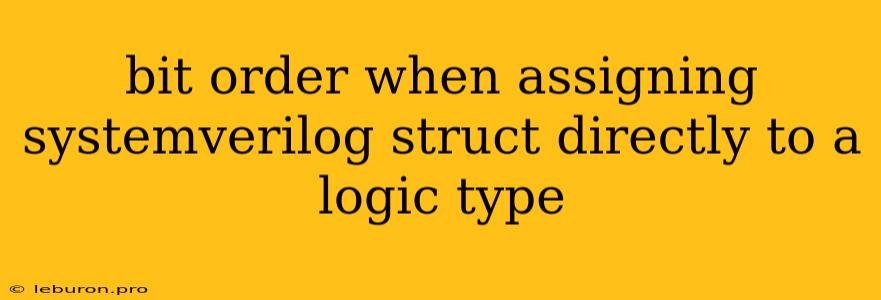The assignment of a SystemVerilog struct directly to a logic type can lead to unexpected results if the bit order of the struct's members doesn't match the bit order of the logic type. This is because the compiler doesn't necessarily guarantee a specific bit order for structs, and the bit order of the logic type is determined by the hardware implementation. To avoid issues, it's crucial to understand how bit order affects struct assignments and to implement strategies that ensure data integrity.
Understanding Bit Order
Bit order, also known as endianness, refers to the order in which bits are stored in memory. In SystemVerilog, there are two main bit order types:
- Big endian: The most significant bit (MSB) is stored at the lowest memory address.
- Little endian: The least significant bit (LSB) is stored at the lowest memory address.
The bit order of a logic type is typically determined by the underlying hardware platform, while the bit order of a struct is not specified and can vary depending on the compiler and synthesis tool.
Bit Order Issues with Struct Assignments
When assigning a struct to a logic type, the compiler might not align the struct members with the corresponding bits in the logic type. This mismatch can lead to data corruption and unexpected behavior. Let's illustrate this with an example:
typedef struct packed {
logic [7:0] data1;
logic [3:0] data2;
} my_struct;
logic [11:0] logic_data;
my_struct struct_data;
// Assign the struct to the logic variable
logic_data = struct_data;
In this example, if the struct members are stored in big endian order and the logic type is little endian, the following could happen:
- struct_data.data1 (8 bits) is assigned to the higher bits of logic_data.
- struct_data.data2 (4 bits) is assigned to the lower bits of logic_data.
This results in a data mismatch, potentially leading to incorrect values in the logic type.
Strategies for Avoiding Bit Order Issues
To ensure data integrity during struct assignments, consider the following strategies:
1. Explicitly Specify Bit Order
You can explicitly specify the bit order of a struct using the packed keyword. This ensures that all members are packed together in a specific order, regardless of the compiler's default behavior.
typedef struct packed {
logic [7:0] data1;
logic [3:0] data2;
} my_struct;
In this example, the packed keyword forces the struct members to be stored in a contiguous memory location. This can prevent unexpected behavior during assignments.
2. Use Unpacked Structs with Explicit Assignments
Instead of directly assigning a packed struct to a logic type, you can create an unpacked struct and assign its members individually to the corresponding bits in the logic type.
typedef struct {
logic [7:0] data1;
logic [3:0] data2;
} my_struct;
logic [11:0] logic_data;
my_struct struct_data;
// Assign the struct members individually
logic_data[11:4] = struct_data.data1;
logic_data[3:0] = struct_data.data2;
This method provides more control over data placement and guarantees correct alignment.
3. Use a Bit-Level Access Method
SystemVerilog provides a bit-level access method using the $bits function, which allows you to access individual bits within a logic type.
logic [11:0] logic_data;
my_struct struct_data;
// Assign individual bits using $bits
$bits(logic_data)[11:4] = struct_data.data1;
$bits(logic_data)[3:0] = struct_data.data2;
This method ensures data integrity by accessing the bits in the logic type directly, regardless of the bit order of the struct.
Best Practices
- Understand the hardware platform's bit order: Always be aware of the bit order of the underlying hardware platform to avoid unexpected behavior.
- Use packed structs with caution: While packed structs can be convenient, use them carefully and ensure that the bit order is consistent between the struct and the logic type.
- Document bit order assumptions: Clearly document any assumptions made regarding bit order to avoid confusion and maintain code readability.
By following these strategies and best practices, you can effectively manage bit order issues and ensure data integrity when working with structs and logic types in SystemVerilog.
Conclusion
The bit order of structs and logic types in SystemVerilog can significantly impact data integrity during assignments. Understanding the potential issues and implementing the strategies outlined above can help you avoid unexpected behavior and ensure that your code behaves as intended. By carefully considering bit order during struct assignments, you can write robust and reliable SystemVerilog code.
